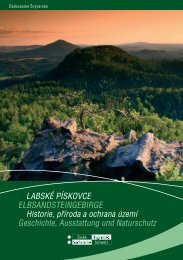ABSTRACT BOOK Sandstone Landscapes ... - Sandstones.org
ABSTRACT BOOK Sandstone Landscapes ... - Sandstones.org
ABSTRACT BOOK Sandstone Landscapes ... - Sandstones.org
You also want an ePaper? Increase the reach of your titles
YUMPU automatically turns print PDFs into web optimized ePapers that Google loves.
PLenka VoříškováNational Park České Švýcarsko Administration, Pražská 52, CZ-407 46 Krásná Lípa, Czech Republic(l.voriskova@npcs.cz)Bryophyte diversity of České Švýcarsko (Bohemian Switzerland) National ParkThe area pattern of České Švýcarsko (Bohemian Switzerland) conditions two different views ofbryophyte species diversity. On the one hand species low rich communities occur there frequently which isrelated to the occurence of nutrient-poor soils on sandstones. Apart from this there occur species which areconnected with unique microhabitats (e.g. rock fissures) related to strong and specific broken topography.Together there are found species the occurence of which is determined by climate of the inversion sites(ravines) and also by generally oceanic-suboceanic pattern of this area. Thanks to these unique climaticconditions this area amounts to the one of the most richest sandstone areas in the Czech Republic as far asbryophyte species are concerned. From the standpoint of phytogeography mostly temperate species arerepresented (26%), more than one fourth of species is boreal-montane, almost 10% of species is oceanicsuboceanic.Tetraphis pellucida, Calypogeia integristipula, Lepidozia reptans, Dicranella cerviculata,Dicranella heteromalla, Dicranodontium denudatum, Mylia taylorii and Pellia epiphylla are representativesof the most common sandstone rocks communities.Many species are not too frequevent in the area. These species are dependent on habitats withspecific micro-mesoclimate or unique substrate:In vertical rock rifts or under shaded rock ledges Tetrodontium brownianum occurs.Of many species characteristic of the inversion sites of this area subarctic-alpine species Lophoziagrandiretis, Dicranodontium asperulum and Hygrohypnum ochraceum, subarctic-subalpine mossesOligotrichum hercynicum, Polytrichum alpinum and Tetrodontium repandum, a subalpine liverwortAnastrophyllum michauxii and montane liverworts Pellia neesiana and Tritomaria execta can bementioned.Frequent occurence of suboceanic-oceanic bryophytes supports oceanic area pattern, among theme.g. Kurzia sylvatica, Cephalozia connivens, Campylopus fragilis, Plagiothecium undulatum, Rhabdoweisiacrispata or Rhytidiadelphus loreus.On calcareous sandstones basiphilic bryophytes e.g. Pedinophyllum interruptum, Lophoziabantriensis, Fissidens gracilifolius or Neckera crispa occur.On decayed wood very rare and endangered species Cephalozia leucantha, Riccardiachamaedryfolia a R. latifrons occur among the other.On secondary habitats rare and endangered mosses Syntrichia latifolia and Didymodon spadiceusare found.Markedly Orthodontium lineare invasion shows in the whole area. On some localities occurence ofanother invasive species Campylopus introflexus has been observed.More than 270 species of bryophytes (30% liverworts, 70% mosses) have been recorded in thearea of National Park České Švýcarsko, out of which „Preliminary lists of threatened bryophytes in theCzech Republic“ include 34 species, e.g. Anastrophyllum michauxii, Jamesoniella autumnalis, Lophoziagrandiretis, Pedinophyllum interruptum, Riccardia chamaedryfolia, R. latifrons, Atrichum tenellum,Campylopus fragilis, Didymodon spadiceus, Fissidens gracilifolius, F. rufulus , Rhynchostegium confertumor Tetrodontium brownianum. Some of these threatened species e.g. Geocalyx graveolens, Harpanthusflotowianus, H. scutatus, Jungermannia caespiticia or Nowellia curvifolia are only historical data, recentlytheir occurence hasn´t been corroborated yet.




